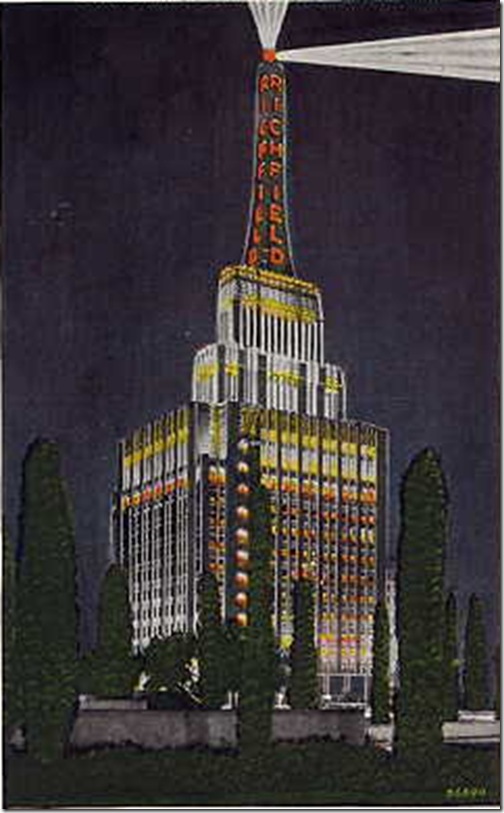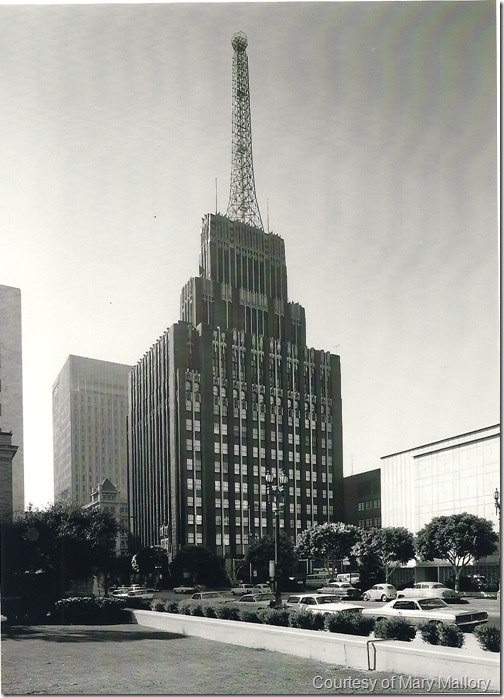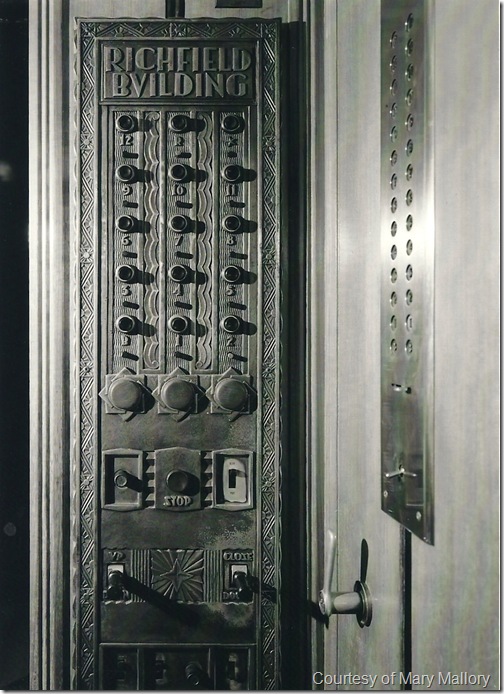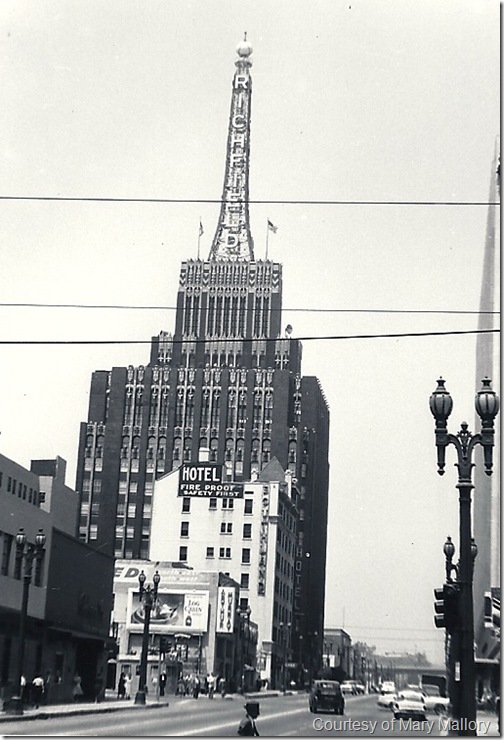
The Richfield Building in an undated postcard.
After years of deprivation, darkness and worry during World War I and its aftermath, America was ready to look toward a shining future of prosperity and sunshine in the 1920s. Overnight, fashion, music and the arts embraced change, style and risk-taking. Much was modeled after the 1925 Exposition International des Arts Decoratifs et Industriel Modernes in Paris, which displayed bold conceptions of applied arts, reveling in eclectic, glorious design. The new style embraced technology and the machine age, reflecting a belief in a dynamic, energetic future.
Architecture celebrated the Moderne style as well. Color, geometric shapes and lavish ornamentation replaced monochromatic massing in buildings. Triangles, sunbursts and zigzags screamed progress in modern buildings as they stretched toward the sky. New York’s Chrysler Building exemplified the new look, bold, sleek and gorgeous. The American Radiator Building also embraced the modern by daring to wreath itself in gold and black colors, a glamorous and contemporary design.
Mary Mallory’s “Hollywoodland: Tales Lost and Found” is available at Amazon.

The Richfield Building in the 1960s, courtesy of Mary Mallory
Los Angeles’ Richfield Co. looked to shake things up in Los Angeles too, by grabbing the spotlight as a leading player in the oil industry. Their new headquarters at 555 S. Flower St. would be the siren announcing their explosive future in reshaping the petroleum industry.
In late 1928, Richfield hired Morgan, Walls and Clements, one of Los Angeles’ premier architectural firms, to conceive a bold, forceful building as their headquarters. Founded by Ezra F. Kysor in 1868, Morgan, Walls and Clements evolved over the years into a leading designer of important office structures. Stiles O. Clements, their chief designer, had studied at Drexel Institute of Technology, MIT and the Beaux Arts Academy in Paris before joining the firm in 1913.
Clements embraced the Radiator Building as a model, copying its gold and black colors and vertical design of windows and lines in the downtown Richfield Building. The colors saluted Richfield’s moneymaker, its Texas tea. Turning the inside out, luxurious color and glamorous detail would jazz up the building’s exterior and dominate the bland Los Angeles’ skyline.
As David Gebhard explains in the monograph, “The Richfield Building 1928-1968, the bold and visionary sheathing was beautiful as well as functional, and an excellent match for its gold ornamentation. The Architectural Record noted that, “The walls are black to prevent undue contrast with the countless windows which might destroy the silhouette.” The gold drew out the black, giving it a sophisticated glamour that other buildings lacked. Gold highlighted the vertical nature of the windows, which the architectural firm called, “An expression of modern art and thought” in an unpublished press release.
Contractor P. J. Walker hired Consolidated Steel Co. to fabricate the steel frame on which the $1.75-million building would sit, designed by Erick and Deline, engineers. 2,300 tons of steel composed the framework, erected in a record 31 days in early 1929. Tile designed by Gladding, McBean, and Co. lined the building’s exterior. Fred Ortman of the company described the makeup of the tile in the July 14, 1929, Los Angeles Times. “On a body composed of imported English clay, local ball clay, feldspar and flint, the glazes, colored with exact percentages of iron peroxide and manganese oxide, were sprayed on in a green state and burned with bodies to form a homogeneous mass. A yellow glaze was produced as a base color for the gold, which is the genuine California article, the precious metal was then applied to this and burned twice, producing a dull, lustrous effect, which will gleam in the rays of the California sun as long as the building stands.”

A Richfield Building elevator, courtesy of Mary Mallory.
The Richfield Building’s exterior dark green tile only appeared black from the sun’s reflection off the mirrored surface. Real 14-carat gold leaf was contained in the gold surfaces lining the windows and sculptures. “The gold ornamentation is of terra cotta coated with a layer of finely pulverized gold, held in suspension in a transparent glazing solution,” per the Architectural Record.
The entrance featured Belgian black marble, Cardiff green stone trimmings, Russian bronze metalworks, Benedict nickel hardware, rubber tile on the floor, and black lacquer-coated woodwork. Six high-speed, etched metal elevator doors and two freight elevators were installed beginning April 20, 1929, the first on the West Coast. The building’s two-story underground parking garage was also one of the first ever installed in an office complex. The building itself was a giant U-shape, actually two wings united by the façade on Flower Street.
Sculptor Haig Patigian was hired to design massive, dominating gold figures lining the top of the structure, and four terra-cotta figures above the entrance. Patigian described his work in a Morgan, Walls and Clements press release. “I designed all the sculpture in question with two principles in mind – to keep in harmony with the architecture of the building and to have my ideas conform in a measure to the business and business connections of the Richfield Co. The figures around the top with their…powerful torsos and decorative design of wings…symbolized motive power.” The statues embraced the future while saluting the past, an updated copy of monumental art that had decorated structures for hundreds of years. The four figures above the entrance represented the fields of Aviation, Postal Service, Industry and Navigation, all vital to Richfield’s success.
The air-conditioned structure contained 11 floors of offices, with the 12th the social hub of the building. Here could be found the main lobby, cafeteria, executive dining rooms, barbershop, showers, massage room, ladies’ lounge, assembly room with a stage, and rooftop garden.
Topping the luxurious wedding cake was a 125-foot-tall beacon tower, a visual play on an oil derrick, providing a searchlight for airplanes, a possible decking location for zeppelins, and a floodlight to illuminate the building. The Richfield name lined the tower’s sides in eight-foot-tall neon letters, which The Times called “a brilliant red candle in the sky.” It weighed 70,000 pounds itself. The colorful building and its flashy billboard soon dominated the downtown skyline.
The Richfield Building’s 12th floor soon became a social gathering spot for clubs, universities and other business organizations, which rented the assembly room and dining rooms for meetings, parties and conferences.
Tragedy struck on Aug. 29, 1950, when 40-year-old land and lease office attorney Dudley Eugene Brown committed suicide by jumping from a 12th floor office, climbing over a glass windbreak to jump. During the fall, Brown struck a 10th-floor ornamental promontory, which pushed his body beyond the sidewalk and into the street.
Two painters suffered critical injuries on Aug. 12, 1953, when they fell 50 feet from scaffolding that collapsed while they painted the tower, throwing them to the 12th floor of the building. Injuries included fractured arms, legs, hip, ribs, skull, and internal injuries.

The Richfield Building, courtesy of Mary Mallory.
Unfortunately, “progress” caught up with the gorgeous building. Some people now considered the structure garish, gaudy, and a monstrosity, and new skyscrapers dwarfed its size. The Richfield Co. merged with Atlantic Refining Co. in 1966, and decided that the building was not producing enough revenue. They purchased surrounding buildings, creating a property flagged by Flower, Figueroa, 5th, and 6th Streets, and decided to turn it into a mini Rockefeller Center in 1967, called the Atlantic Richfield Plaza. The site would be composed of two 52-story towers, open space, promenades and other buildings. Louis Ream informed The Times on March 9, 1967, that “We’d like to think as big as possible – the economics of a site like this dictates that we do.” He claimed, “The building is beautiful, but it is only 54% usable. We’re planning on tearing it down, with tears in our eyes.”
Groups immediately opposed the planned destruction, arguing for preservation and inclusion of the building in the new project. Denise Scott Brown, a UCLA professor of urban design, attempted to rally supporters to fight for the building, decrying both Atlantic Richfield’s aim and the city’s destruction of Bunker Hill, “simply because we tend to despise our immediate past.” Instead of the raw and dead land left by urban renewal’s wiping away all traces of the historic past, she suggested renovating and integrating the building into the project, saying its bold design could stand up to the modern, glass structures. Unfortunately, the fledgling historic preservation movement was not strong enough to withstand the powerful forces opposing it.
Wrecking crews entered the building’s interior on Nov. 12, 1968, and began dismantling the building. The elevator doors were saved, but not much was salvaged or preserved. The Cleveland Wrecking Co. was hired to remove the 40 towering figures from the top of the structure. In two weeks, they removed them by tying chokes around their necks and waists before cutting away the concrete, leaving only the top torso of the figures. Two were decapitated, and others suffered broken noses or wing tips in the process. The company removed the figures to their yard, where they were sold for $100 each, the cost it took to remove them from the building.
Ironically, in September 1969 an exhibit at the Building Exhibition Center celebrated the centennial of Robert Clements and Associates, the heir to Morgan, Walls and Clements, with drawings of the former Richfield Building.
While the beautiful Richfield Building was lost, it helped galvanize growing support for historic preservation and reuse and adaptation of historic structures, leading to the formation of such groups as Los Angeles Conservancy and Hollywood Heritage. Today, developers and builders are rapidly renovating and rehabbing glorious apartment buildings, hotels, and theatres in downtown Los Angeles, allowing historic structures to once again shine as the lovely monuments they were intended to be.


Very interesting, Mary. As I no longer live in L.A., I guess I’d always presumed this building still stood. Here’s a testament to what greed, small-thinking and idiocy can do. Much like in NYC, where the losses of such great buildings as the historic and beautiful Singer Building (extant only 60 years) and the original and iconic Pennsylvania Station (which only stood for 53)–the ONLY good thing that can be said is that the fury over such nonsensical, greed-based land-grabs got funneled into organized preservation groups. What the hell happened in the 1960’s, anyway? Can anyone name a single “great” building erected from 1960-70? Me either (if anyone mentions the Dorothy Chandler Pavillion–or even Lincoln Center, for that matter, I will hunt you down!). If you want to see something hilarious/horrifying, check out a picture of the building they came this-close to erecting on the site of Carnegie Hall in New York–when it was very nearly torn down. Thank GOD the preservationists (led by famed violinist, Isaac Stern) were successful this time in saving one of America’s greatest buildings ( link to photo…scroll down a bit on the page, if you like: http://didyoujustseewhatisaw.blogspot.com/2011/04/thank-god-wiser-heads-prevailed.html ). When I read that quote in your article “We’re tearing it down with tears in our eyes”…it makes me want to spit food. Greedy hypocrite. One wonders why, in such a forward-thinking time as the late 1920’s, the enormously prosperous company that was Atlantic Richfield didn’t build their headquarters taller to begin with? Could that have saved it, had it been the case?
LikeLike
Gregory, thanks for the link. Unfortunately the building couldn’t have been built taller in the 1920s because no building could be taller than city hall. Without the tower they could have added a few floors, but that would have been it.
LikeLike
The message was clear, politicians like to be looked up to.
LikeLike
I take exception to Gregory’s comment about there being no great buildings 1960-1970. Off the top of my head I could name Saarenin’s Twa Terminal and CBS (The Black Rock) Building as well as Wright’s Guggenheim Museum, all in NYC and Kahn’s Kimball Art Museum in Fort Worth. As for LA let’s not overlook all of those case houses. In fact that decade contains many of the most brilliant examples of modern architecture.
LikeLike
To each one’s own….but I’ll stand by my very broad statement (to which there are, of course, a few exceptions). My own opinion is along the lines of: Put the CBS Building next to, say, The Bradbury Building. I’m taking the Bradbury. I just find it maddening to see the atrocious 1960’s buildings that replaced some of America’s greatest buildings (NYC Penn Station, most of all). In the 1960’s, perhaps more than any single decade in modern history, the way of thinking seemed to be “Old is bad…tear it down”. And the style that was then in vogue…well…it seems that it’s a very small minority, indeed, that would consider it even marginally resemblant of “grand epoch” of architecture. And not to pick nits, but the Guggenheim was built in 1959, so technically….
LikeLike
The period from 1960-70 was the decade Modern architecture died. Many of the completed buildings became a symbol of modernism’s fall from grace. Most high-rise buildings produced during this period had become in most instances monolithic, an un-ornamented style which was often seen as soulless and bland, overly simplistic and abstract. In fact the decade contains many of the most oppressive examples of architecture, distressing visual ugliness and ungraceful cost accounting functionalism (e.g., Pan Am Building). The production in public housing projects also increased. Many large urban housing projects were constructed during this period, such as the Robert Taylor Homes, Moss Park, Ebbets Field being replaced with an apartment complex, and the Million Programme in Sweden. These projects have become an icon of urban renewal and public-policy planning failure. The post war urban planning policies implemented during the start of the 1950s is really to blame though. As a result, many older buildings were demolished to make way for new infrastructure and redevelopment. It was the butchery of our scenery and the despoiling of our landscapes and a rational, plain, and homogeneous change in our architectural imagery. They destroyed many communities and innovative economies by turning our cities into isolated, unnatural urban areas. These sort of ideas is what brought on the revival of architectural criticism in the press, the birth of the historic preservation movement, and the changing culture and politics of our cities and even the highway revolt. When you look at all these factors, 1960-70 was a decade that failed both architecturally and civically.
LikeLike
Saw this building often after we moved to L.A. in the sixties. I lobbied my parents to buy one of the statues for $100, but noooo. Forty five years later, I’m STILL disgusted by its destruction. To see a bit of what we lost, go to http://www.lamag.com/citythink/askchris/2013/09/09/rent-this-rare-art-deco-jewel-box
LikeLike